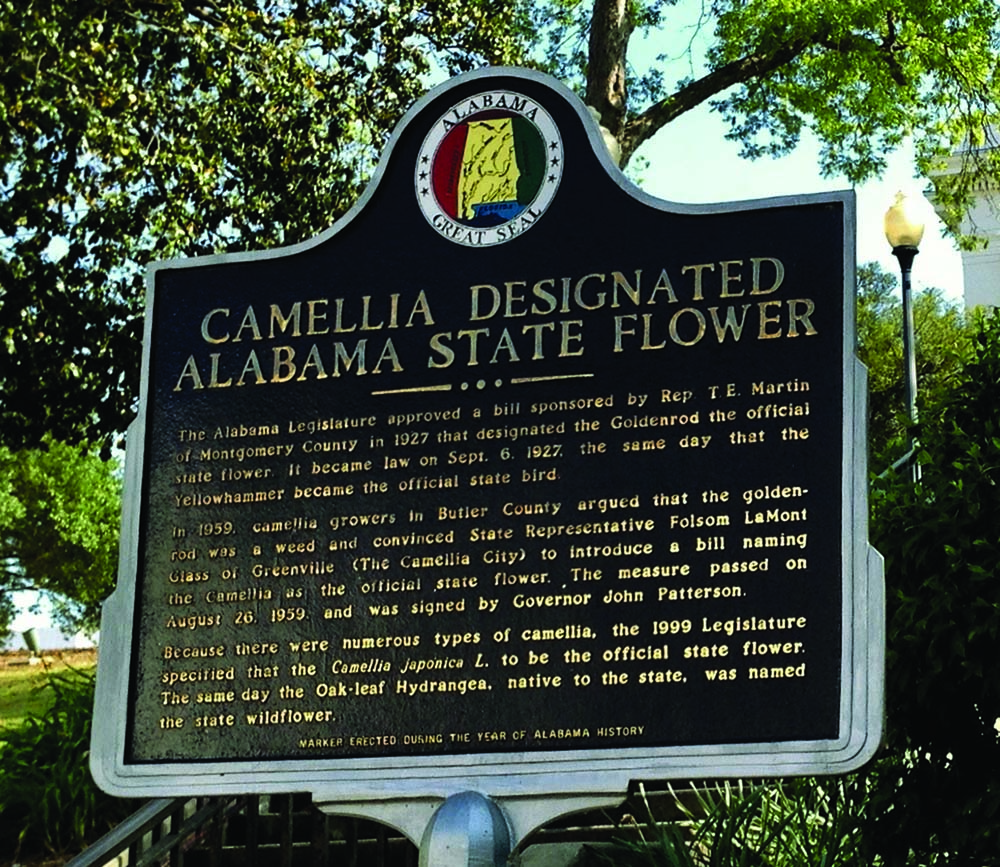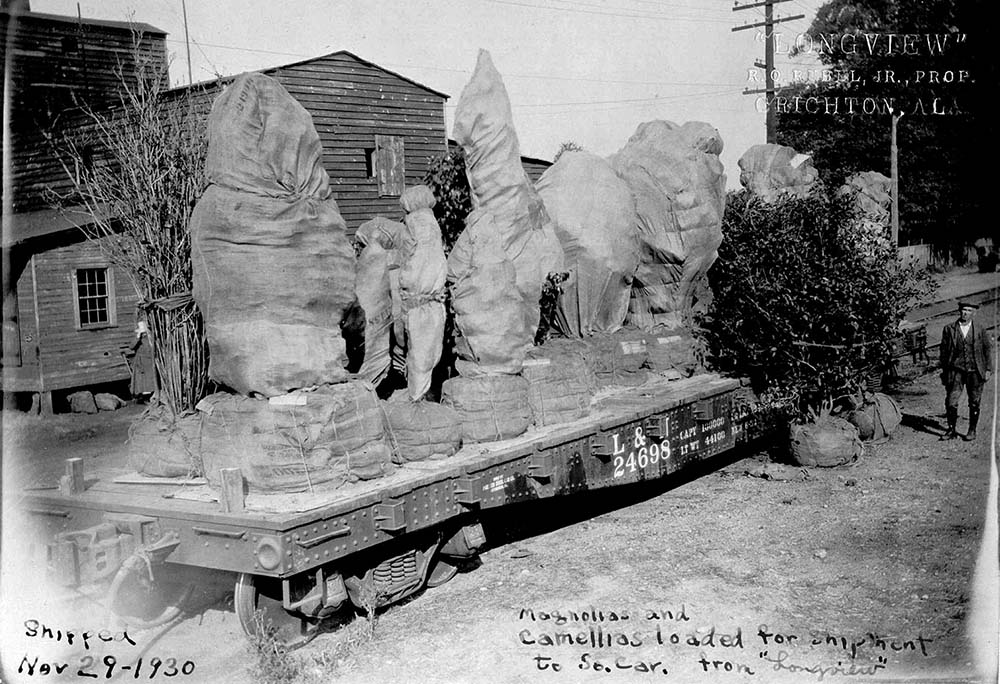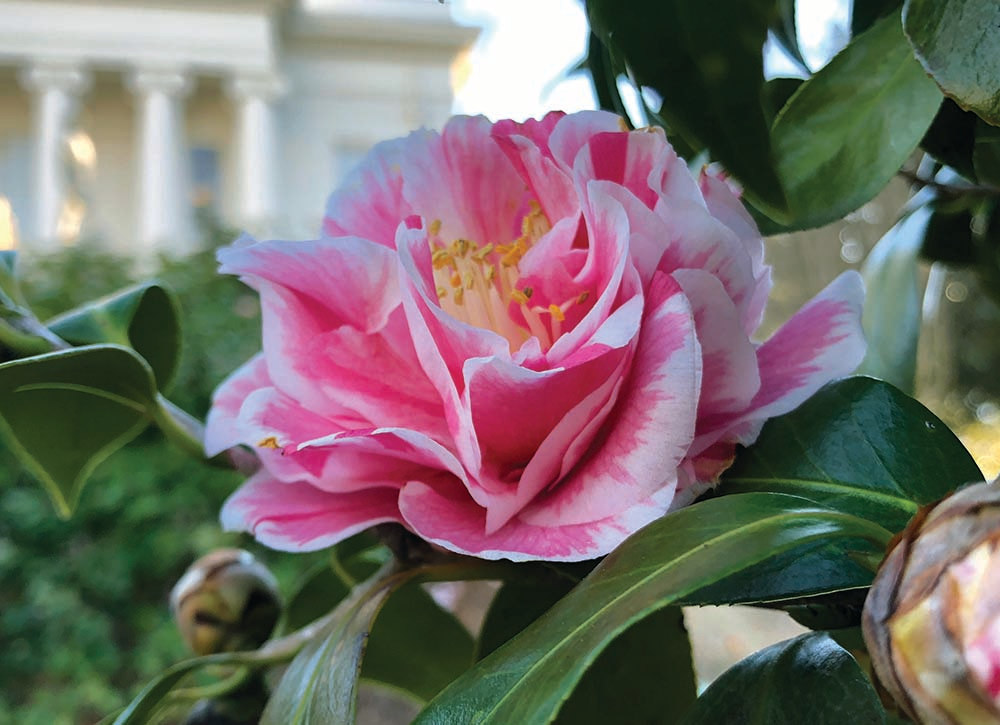It’s adorned landscapes, tabletops and even the gowns of first ladies here in Alabama for more than 200 years, but how did the camellia, an import from Asia, become our state flower 60 years ago?
That story is a tale of adoration, tenacity and a bit of conflict that will be recounted and celebrated Feb. 15-18 in Mobile, the city where Alabama’s camellia culture first took root, as the Alabama and the American Camellia societies join forces for their annual meetings and a mega-flower show.
Held in conjunction with Alabama’s Bicentennial celebration, the event commemorates the 60th anniversary of the camellia becoming Alabama’s state flower while also welcoming hundreds of camellia lovers from across the nation to help celebrate the history and future of this beloved, storied plant.
Camellias have long been adored for their glossy, evergreen foliage and exquisite flowers, which burst into bloom during the fall and winter. According to the American Camellia Society’s website, the Camellia genus encompasses more than 200 species of plants including C. sinensis, the source of pretty much all the tea in China and the world.
The genus also includes several ornamental species — the two most common of which are the fall-blooming C. sasanqua and the winter-blooming C. japonica. These and a handful of other camellia species are the foundation plants for more than 3,000 named varieties and hybrids that produce a diverse and sumptuous selection of bloom colors, sizes and petal arrangements.

All the world loves a camellia
Though camellias have been revered and cultivated for thousands of years in their southern and eastern Asia homelands for their tea-producing leaves and breathtaking flowers, it was a thirst for tea that brought them to England and other parts of Europe and the Middle East in the 16th and 17th centuries. Enamored with — or more properly, addicted to — tea, the British began importing C. sinensis plants by the thousands, and with those shipments, whether by accident or not, came some of the ornamental varieties.
By the late 1730s, camellias were becoming almost as popular as tea in Europe and, by the late 1700s, they had been introduced into America.
Camellias, though a source of adoration for many, were also the cause of conflict, says Forrest Latta, a Mobile camellia devotee and member of the conference planning committee who has what he calls a “historic imagination.” He loves learning about the stories of camellia plants and their people.
“What plant has inspired two wars?” queried Latta. The answer: camellias, which were catalysts for the American Revolutionary War (remember the Boston Tea Party?) and the Opium Wars (a series of conflicts fought between China and England in the 19th century over the British trade of opium for tea).

Photo courtesy Alabama Camellia Society
Despite these conflicts, camellias also brought together some ardent allies, particularly here in Alabama where the plants grew exceptionally well and were commonly planted in landscapes and yards throughout the state as early as the mid-1800s. According to Latta, those allies included a quartet of men who made Alabama a hub of camellia production, innovation and commerce in the early 1900s.
“Lightning strikes sometimes and, like Silicon Valley in the technology world, in the gardening world it struck in Mobile, Ala.,” Latta said. That “lightning” was generated by four Mobile residents: Tom Dodd, Tsukasa Kiyono, Robert Rubel and Kosaku Sawada, all names that remain iconic in the camellia’s story. Each man was independently growing, developing and selling camellias through their nursery businesses.
From their inspired and tenacious work sprang many named varieties and Alabama’s still-flourishing nursery industry. They also helped make camellias a must-have plant for gardens in the state, region and nation, including in the now world-famous Theodore, Ala., garden of Bessie and Walter Bellingrath.
Camellia cities
Though camellias are an iconic plant of Mobile, Greenville, Ala., is where the effort to make the camellia our Alabama state flower began, a story that brought on another bit of conflict.
According to historical records, after overhearing a visiting garden editor from a national magazine comment on the large number of handsome and old (some dated back to the mid-1800s) camellias in Greenville, a local newspaper editor began using the slogan “The Camellia City” on his paper’s masthead. Soon city officials and civic and business folk (including a local dairy that used pictures of camellias on its milk cartons) also adopted the slogan.

The camellia was named Greenville’s official city flower in the late 1930s, and is also where, in 1948, the Alabama Camellia Society was founded. A year later, those Greenville-based camellia champions began lobbying to replace the goldenrod, which had been named Alabama’s state flower in 1927 (the same day the yellowhammer became our official state bird), with their favorite flower.
The first camellia bill, sponsored by Sen. Jimmy Faulkner of Baldwin County in 1949, failed. But the camellia camp was undeterred. They touted the attributes of camellias, including their beauty, ease of cultivation and tourism potential.
A June 4, 1959, Alabama Journal article reported that, as the Legislature’s Conservation Committee met to vote on moving the bill forward for a full vote, they had company – “the camellia crowd, made up primarily of formidable-looking women.”
Later that month, the bill passed and was signed into law by Gov. John Patterson on Aug. 26, after which Patterson’s wife, Mary Joe McGowin Patterson, who had connections in Greenville, reportedly said, “Good, I can go home tonight!”
In 1999, to clear up any confusion about which camellia was the state flower, the Legislature passed another bill designating Camellia japonica L. as the official Alabama camellia species. (At the same time, perhaps to quell some of the goldenrod angst, legislators also named another native flower, the oak-leaf hydrangea, as Alabama’s state wildflower.) In 2014, the Legislature also proclaimed Jan. 7 of each year as Alabama’s “Camellia Day,” a date picked to coincide with the start of C. japonica’s prime blooming season.

Despite the conflicts it may have incited, the camellia remains a beloved plant to many, including the thousands of tourists — and their dollars — who come to Alabama each year to see them in bloom. As Latta says, “Camellias are like apple pie. Everybody likes them.”
And there is a lot to like. These long-lived, low-maintenance plants are available in a wide range of sizes, from dwarf shrubs to 15-foot trees, which can fit any landscape design needs. And when their showy blossoms open to show myriad hues of solid and variegated white, pink and red, often with adorned with yellow-to-gold stamens, “like” can easily become “love.”
Plus, said Latta, they are a reminder of how lucky we are to live in Alabama. “Where else but Alabama can you go out in the yard in the middle of February and get cut flowers?” he asked.
Then there’s the human connection. “I think of camellia stories as people stories,” Latta says, noting that the adoring and tenacious men and women who have, and still do, love and propagate them are as unique as the plants themselves. “Every beautiful camellia you see has a human pedigree.”
Want to hear more of the story — or become part of it? Latta said this year’s convention offers a once-in-a-lifetime chance to do just that. “Or just come to the free flower show on Feb. 17,” Latta suggested. “You’ll see a floral fireworks and leave a changed person.”
 Celebrate camellias
Celebrate camellias
Help celebrate the 60th anniversary of Alabama’s official state flower, Camellia japonica, which coincides with Alabama’s 200th year of statehood and the annual meeting of the American Camellia Society, by coming to Mobile Feb. 15-18 for three days of flowers, fun and history.
Registered participants will see outstanding camellia gardens in the Mobile area at their peak bloom, including Bellingrath and Mobile Botanical gardens and several private collections.
In conjunction with the Alabama 200 Commission, the convention also features a free public flower show featuring spectacular blooms from across the state and nation to be held at the Mobile Convention Center on Feb. 17 from 1-5 p.m.
To learn more about the conference, contact Chuck Shirk at 251-422-0398 or visit AlabamaCamelliaSociety.org or the “Alabama Camellias” Facebook page, which offers hundreds of photos and stories about Alabama camellias and the people, past and present, who adore these plants.
In addition to the convention’s mega-flower show, several smaller shows will be held this month in Semmes (Feb. 2), Dothan (Feb. 9) and in Birmingham and Auburn (both on Feb. 23). For more information on these and future events or to explore membership opportunities with state or local camellia organizations, visit americancamellias.com and click on “about” and then “clubs and societies.”
 Cultivate camellias
Cultivate camellias
Thinking of adding camellias to your landscape? Here are some tips to ensure they thrive and provide the best color in fall and winter landscapes.
Sites: For best growth and flowering, plant camellias in partial shade and in an area protected from strong winds; they grow well under pines but don’t compete well with hardwood tree roots.
Varieties: With more than 3,000 named varieties, there’s a camellia to fit any color, bloom-type and plant size preferences; if you live in colder parts of the state, make sure to choose cold-hardy varieties.
Soil: Camellias can be grown in a variety of soil types, but for best results they need an acidic soil (pH 5.0-6.5) that’s well aerated and high in organic matter.
Water: Camellias need adequate water when they are first planted and during growth periods: once established, they tolerate drought better than wet feet.
Planting times: Camellias are best planted in fall and early winter.
Propagation: Camellias can be reproduced from seed, cuttings, grafting and air layering.
To learn more about growing camellias, visit the American Camellia Association website (americancamellias.com), join a local camellia club or check out the Alabama Cooperative Extension publication “The Culture of Camellias” at aces.edu/pubs/docs/A/ANR-0202/ANR-0202.pdf.





